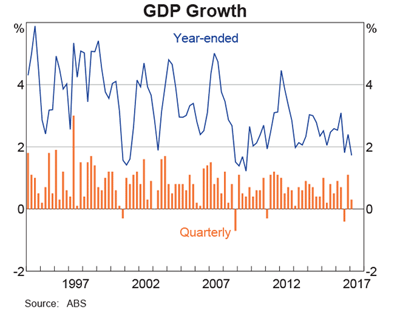This week two banks had interest rate decisions, the Reserve Bank of Australia and the Bank of England. Australia maintained their current rate policy. Their statement contained the following analysis of the Australian economy:
The Bank's forecasts for the Australian economy are largely unchanged. Over the next couple of years, the central forecast is for the economy to grow at an annual rate of around 3 per cent. The transition to lower levels of mining investment following the mining investment boom is almost complete, with some large LNG projects now close to completion. Business conditions have improved and capacity utilisation has increased. Some pick-up in non-mining business investment is expected. The current high level of residential construction is forecast to be maintained for some time, before gradually easing. One source of uncertainty for the domestic economy is the outlook for consumption. Retail sales have picked up recently, but slow growth in real wages and high levels of household debt are likely to constrain growth in spending.
Employment growth has been stronger over recent months, and has increased in all states. The various forward-looking indicators point to continued growth in employment over the period ahead. The unemployment rate is expected to decline a little over the next couple of years. Against this, however, wage growth remains low and this is likely to continue for a while yet.
The recent inflation data were broadly as the Bank expected. Both CPI inflation and measures of underlying inflation are running at a little under 2 per cent. Inflation is expected to pick up gradually as the economy strengthens. Higher prices for electricity and tobacco are expected to boost CPI inflation. A factor working in the other direction is increased competition from new entrants in the retail industry.
The following charts, which are contained in the RB A.s Chart Pack, illustrate several Key Australian economic statistics:



The top chart shows that top line economic growth has fluctuated between two and 3% since 2012. Inflation is currently right around 2% (middle chart) while unemployment is just below 6% (bottom chart). Overall, the Australian economy continues to plug along at a solid pace.
The Bank of England also voted to keep rates at their current level. The policy announcement contained the following general projections for UK economic activity:
The MPC’s overall assessment of the outlook for inflation and activity in the August Inflation Report is broadly similar to that in May. In the MPC’s central forecast, GDP growth remains sluggish in the near term as the squeeze on households’ real incomes continues to weigh on consumption. Growth then picks up to just above its reduced potential rate over the balance of the forecast period. Net trade and business investment firm up, and consumption growth recovers in line with modestly rising household incomes. Net trade is bolstered by strong global growth and the past depreciation of sterling. The combination of high rates of profitability, especially in the export sector, the low cost of capital and limited spare capacity supports investment by UK firms over the forecast period, offsetting the effect of continued uncertainties around Brexit.
There are several problems with the BOEs business activity projections. First, they’re forecasting that trade and business investment will “firm up” in the medium term, which is approximately 18-24 months -- the entire length of the Brexit process. This is a remarkably hopeful projection for an economy that is disentangling itself from its largest trading partner; the reality will probably be much more complicated and chaotic. Second, Brexit will decrease UK trade, which will create spare capacity, that will disincentive the business sector from further investment.
News from the EU continues pointing to a solid expansion. The unemployment rate decreased .1% to 9.1%. France, Spain, Italy, and Greece are skewing this number higher. The latest Markit manufacturing number fell 0.8% to still strong 56.6. The largest economies – Germany, France, Italy, and Spain - all had solid growth. Output and new orders rose. Rising backlogs are increasing hiring. The service sector reading of 55.4 was unchanged. All countries are expanding at a slightly weaker pace which continues to support employment growth. The only concerning news from the EU was from the latest inflation report, where the headline number was 1.3%. The core increased 0.1% rising to 1.2%.
Japanese News was bullish. Industrial production increased 1.6 M/M. The Markit Economics manufacturing number was somewhat weaker, moving 0.3% lower to 52.1. Output and new orders continue to grow but at a slower pace. Employment is also a touch weaker as are export orders. The service index decreased a larger 1.3 to 52. While new orders were weaker, payrolls increased as did labor costs, which may contribute to upward inflationary pressures in the future.
News from Canada was positive. The unemployment rate continued to decline, this time by .2% to 6.3%. While growth in goods producing industries was unchanged, natural resource employment (read: oil extraction) increased 2.4%. This is a very important development: the oil price collapse in 2014 was the primary cause of Canada's modest recession. Service industries accounted for the remaining growth. In other news, the trade deficit widened $2.2 billion due to a 4.3% decline in exports. Recent strength in the Canadian dollar probably contributed to the decline.
